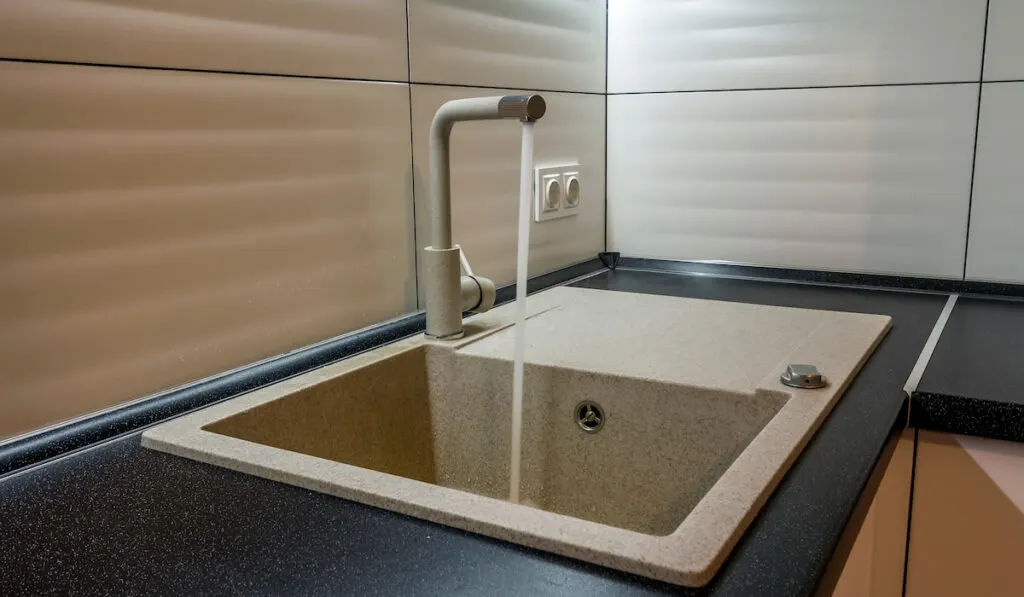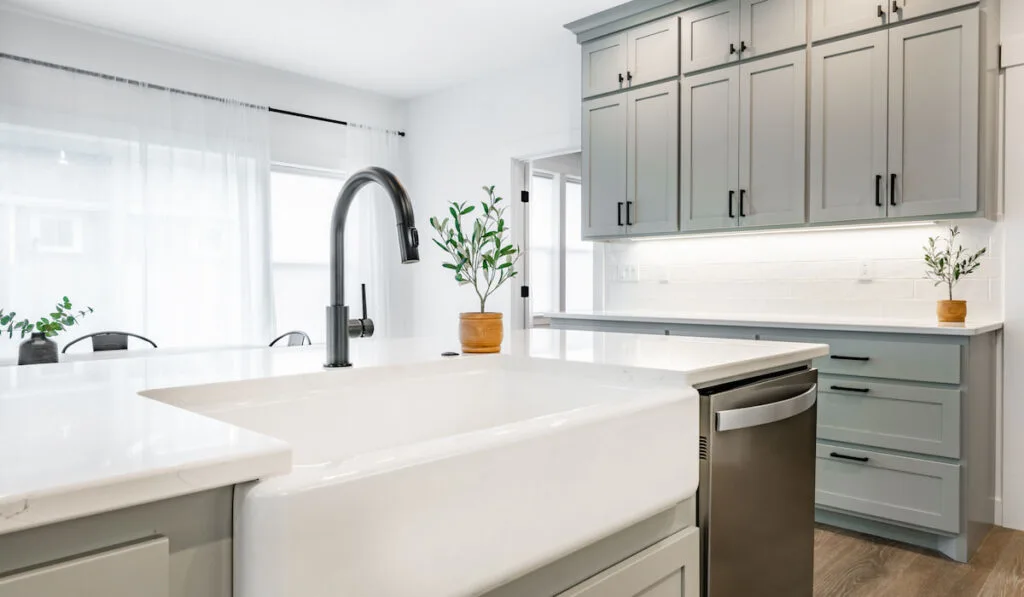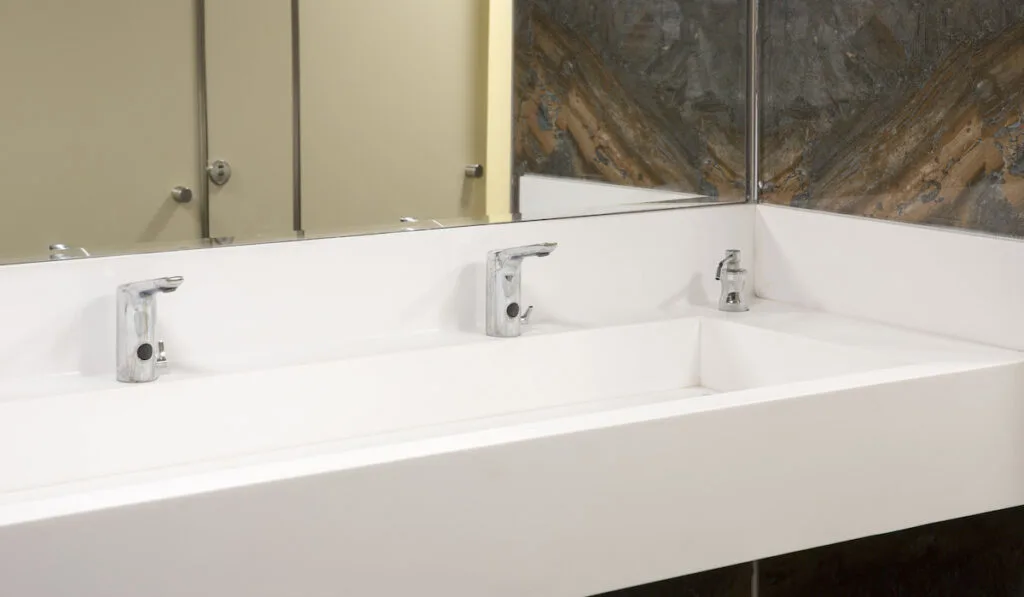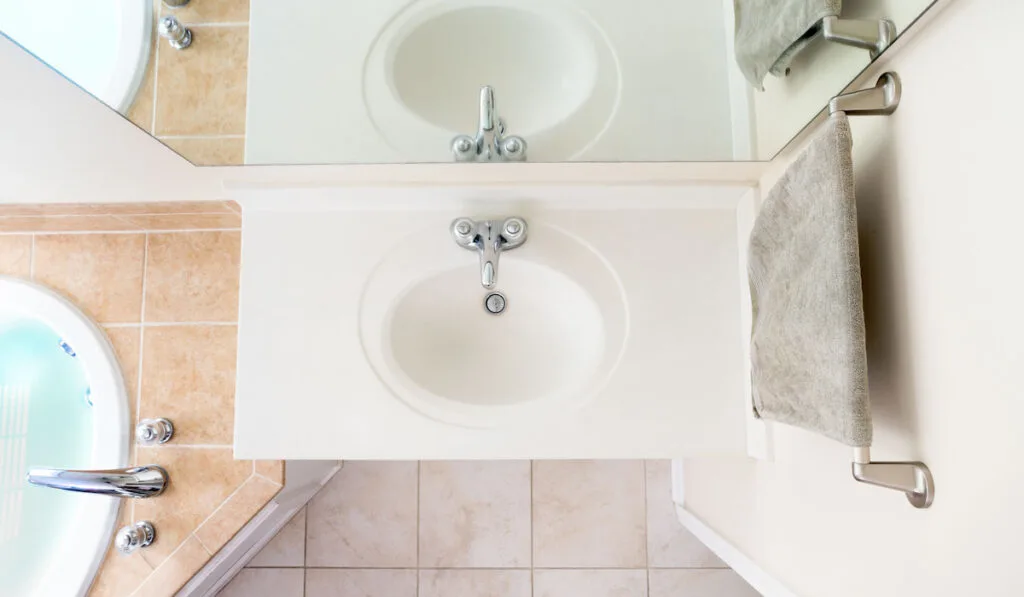*This post may have affiliate links, which means I may receive commissions if you choose to purchase through links I provide (at no extra cost to you). As an Amazon Associate, I earn from qualifying purchases. Please read my disclaimer for additional details.
You may be looking to replace your old kitchen sink with one of a different material. You realize there are many options to choose from. However, you are not yet sold on which of them to settle for.
Well, you are in luck, and you are on the right page. In this post, we discuss various types of kitchen sink materials. We explore their pros, cons, and some considerations before choosing one.
Table of Contents
Stainless Steel
Stainless steel sinks offer a modern look, and they are a good fit when used with wood, granite, or stone countertops.

Stainless steel sinks are relatively cheap, and they are sleek too. While it might seem like sinks made with this material are plain, there are actually fun variants. Nowadays, you will find stainless steel sinks in various colors, finishes, and textures.
Stainless steel sinks are classified into gauges. The higher the gauge, the thinner the stainless steel is.
Now, people might think that thicker steel is always better. But this is not always so. In fact, most people believe the gauge has no effect on the overall quality of a stainless steel sink.
Nonetheless, we should mention that thicker steel sinks are not as noisy as the thinner ones. Also, they resist denting better. However, compared to other kitchen sink materials, stainless steel gives off the most noise.
It is easier to have hairline scratches on thin stainless-steel sinks. Luckily, with a sponge and a mild cleaner, one can get the hairline off readily.
Overall, stainless steel sinks offer resistance; they resist impact, rust, and heat. They are also easy to clean. Their surfaces are smooth, so germs and odor do not stay long on them.
Pros
- Easy to clean.
- Relatively inexpensive.
- Resistant to impact, heat, and rust.
Cons
- Noisier than other materials.
- Shows scratch signs and water spots more readily than other materials.
Copper
Copper sinks have been around for a while. They infuse a warm, rosy color in the kitchen – most times, they become the focal point. All in all, they are attractive.

Beyond being attractive, copper sinks offer various other features, including their antibacterial properties. Copper sinks are said to kill 99.9% of bacteria by disrupting their membranes.
In other words, you will not have to worry too much about hygiene with a copper sink.
The process of corrosion of copper sink is called patination.
Patination results in a dull luster and brown discoloration of copper sinks. With time, copper sinks may also develop a blue-green hue as they patinate.
Many people do not try to stop this process. In fact, it is hard to stop it. But the good news is, it can be slowed down.
Copper sinks come with a smooth or hammered finish. They are also available in different patina finishes.
As with stainless steel sinks, copper is measured in gauges. But in this case, you may want to avoid cheap, thinner copper sinks because they get damaged easily.
One of the main issues you may face when getting a copper sink is finding the perfect size. There are typically no standard sizes for copper sinks since they are commonly made by craftsmen.
In other words, you may have to get a craftsperson to create a custom-made copper sink, and this may make it a bit expensive.
Pros
- It has antimicrobial properties.
- It comes in various patina finishes, giving you multiple options to choose from.
- It has an attractive appearance.
Cons
- It can be noisy like stainless steel sinks.
- Low-quality copper sinks are hard to maintain.
- There are typically no standard sizes.
- Copper sinks can be a bit expensive.
Granite

One thing with pure granite sinks is the overall aesthetics. Pure granite sinks have everything: great color, finish, and texture.
Pure granite is undeniably beautiful, and it is available in infinite varieties. It goes so well with granite countertops.
Besides the beauty, granite sinks are resistant to heat, and they are very sturdy. This is understandable since granite is an igneous rock.
Pure granite sinks are not without their downsides, however. For one, they will show no mercy to your glassware. As you already know, they are extremely rigid, so glassware is likely to break on impact.
Apart from that, pure granite sinks have rough surfaces. This means they will trap grime and stains more readily. So, you will have to scrub while cleaning to get the dirt out.
One more thing, pure granite sinks are pretty heavy. If you are going to get one, you have to ensure the supporting structures can hold it.
Pros
- It has visual appeal.
- It is very resistant to heat and impact.
- It is pretty sturdy.
Cons
- The rough surfaces can make it hard to maintain.
- It is heavy.
- It might be a nightmare for glassware.
Cast Iron
Cast iron sinks are constructed under extreme heat. This shows in their durability, heat resistance, and ability to remain beautiful for long.
Ordinarily, iron will rust with time. But since these sinks are made by casting the iron with heavy enamel coating, this is ruled out.
Besides preventing rust, the enamel coating blocks out stains. It also hides water spots, and all in all, it makes maintenance easier.
You can clean them with only water, a mild cleanser, and a piece of cloth. In fact, it is not advised that you use harsh cleaners in cleaning cast iron. Else, with time the surface will wear off.
You can get cast iron sinks in various colors. In many cases, any color other than white will cost you more.
Pros
- It is easy to maintain.
- It is durable.
- It is heat resistant.
Cons
- It is heavier than stainless steel.
- It can be a bit expensive.
Fireclay

Fireclay sinks offer the highest heat resistance – resisting heat up to 1800-2000 °F. This is expected since they were formed with heat. Fireclay sinks are made by molding ceramic clay then kilning it at a high temperature for almost one hour.
After kilning, the molded ceramic is coated with porcelain enamel and left at up to 200°F for 20 hours. The use of high temperature ensures that the enamel fuses with the ceramic clay to strengthen the build.
Fireclay sinks are impervious to dirt and water. They also resist scratching and staining. One downside of fireclay sinks is their weight. They can be pretty heavy. So you will have to ensure that the supporting structure can hold them.
Pros
- Heat resistant.
- Resistant to scratching and staining.
- Impervious to dirt and water.
- Relatively sturdy.
- Easy to clean.
- Long lifespan.
Cons
- It is heavy.
- It can chip or crack if not handled properly.
- It is available in limited colors.
- It can be expensive.
Solid Surface

Solid surface sinks may also be called Corian or Formica. They are made from a mixture of acrylic resins and/or polyester with mineral compounds. This material works not only for sinks but for tubs and countertops too.
Solid surface sinks have a similar appearance to enamel sinks. But they are not as expensive or as heavy as enamel sinks.
Solid surfaces are a decent alternative if you are trying to avoid the porosity of stone sinks. Their non-porous surfaces make for easier maintenance since they do not trap bacteria, dirt, or odors.
Solid surface sinks can tolerate heat up to 400°F. They are customizable, and they are available in various versions. Nonetheless, you should be wary when getting the least expensive ones as they may have low-quality acrylic resins.
Pros
- Relatively inexpensive.
- It can be customized.
- It is heat-resistant up to 400°F.
- It is easy to maintain.
Cons
- It may scratch if handled roughly.
- It can be affected by extreme heat.
- It may discolor with time.
Pure Quartz

Some sinks are made of just quartz, a rock-forming substance. While these types of sinks are exquisite, they are also pretty expensive. Perhaps one of the most expensive options you will come across.
Besides being attractive and expensive, quartz sinks are incredibly tough. This makes them durable and resistant to impact. Quartz sinks are impervious to dirt and odor, making them easy to clean.
Pros
- It is very exquisite.
- It is easy to clean.
- It is durable.
Cons
- It is not heat-resistant above 573°F.
- It is pretty expensive.
Composite

Composite sinks are made from a mixture of acrylic resin with either granite or quartz. While the ratio of the mix varies, it is typically one part resin to four parts stone.
The thing with composite sinks is that the quality is similar to that of pure granite or quartz. However, they are cheaper. Besides, composite sinks have a uniform appearance, and they have fewer maintenance issues than pure stone sinks.
Compared to each other, composite granite is said to hold more water. However, it is said to be more durable than composite quartz.
All in all, composite sinks are highly durable. Nonetheless, avoid exposing them to extreme heat as they may crack.
Pros
- It is not as expensive as pure stone.
- It is durable.
- It requires no sealing.
Cons
- It is still more expensive than solid surface and stainless steel.
- It is sensitive to extreme temperatures.
Acrylic

Acrylic is a sturdy polycarbonate plastic used in making sinks and even windows. It is also sometimes present in paints.
Acrylic sinks are attractive and pretty inexpensive. They are also lightweight, and they are available in various designs. They can even be molded into different shapes.
You can look forward to not seeing your glassware break with acrylic sinks. While they are durable, acrylic sinks are unlikely to crack your kitchen wares. But in all of this, acrylic sinks cannot resist extreme heat.
Pros
- It is available in various designs.
- You can remove scratches from it with minor polishing or sanding off.
- It is lightweight.
- It is inexpensive.
- It can be molded into different shapes. So, you can get yours custom-made.
Cons
- It is not heat-resistant to a significant degree.
- It will not last as long as enamel-coated cast iron, stone, or steel sinks.
- It scratches readily.
